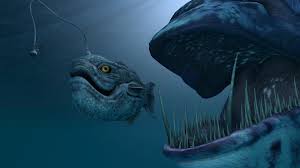Life in the deep ocean is a captivating and mysterious subject. As one of the most unexplored places on Earth, the deep sea is home to an array of strange and unique creatures. These organisms have evolved to survive in extreme conditions such as immense pressure, freezing temperatures, and complete darkness. This essay delves into some of the incredible creatures that inhabit the deep ocean and how they thrive in this harsh environment.
The Deep Ocean Environment
The deep ocean begins around 200 meters (656 feet) below the surface, where sunlight no longer penetrates. The environment here is dark, cold, and subjected to intense pressure—over 1,000 times greater than at sea level in the deepest parts. Temperatures near the ocean floor approach freezing.
Despite these extreme conditions, many creatures have adapted remarkable survival mechanisms to flourish in this unique habitat.

Fascinating Deep-Sea Creatures
Anglerfish: The anglerfish is one of the most well-known deep-sea dwellers, recognized for its distinct method of luring prey. It features a bioluminescent lure that dangles from its head, glowing in the pitch-black water thanks to symbiotic bacteria. When curious fish approach the glowing light, the anglerfish quickly snatches them up.
Additionally, anglerfish have a fascinating mating behavior. The much smaller males attach themselves to females, often permanently, ensuring reproduction whenever needed.
Giant Squid: Another impressive deep-sea inhabitant is the giant squid, which can grow up to 12 meters (39 feet) in length. These squids have enormous eyes that allow them to navigate the dark depths of the ocean. They are swift swimmers and use their long tentacles to catch prey such as fish and other deep-sea organisms.
The giant squid has been the subject of myths and legends for centuries, often depicted as a fearsome sea monster due to its size and elusive nature.
Deep-Sea Jellyfish: Drifting gracefully through the deep ocean, jellyfish are another extraordinary species found in the depths. Some deep-sea jellyfish exhibit bioluminescence, glowing in shades of blue or green to either attract prey or deter predators. One well-known bioluminescent species is **Aequorea victoria**, which emits a bright green light.
Though mesmerizing to watch, their tentacles contain stinging cells that can be harmful to other creatures—and even humans—if touched.

Lanternfish: Lanternfish are small but crucial to the deep-sea ecosystem. These fish emit light through bioluminescence, helping them communicate and find mates in the dark waters. Despite their size, lanternfish play a vital role in the food chain, serving as prey for larger animals like whales and sharks.
At night, lanternfish rise to shallower depths to feed on plankton and return to the safety of deeper waters during the day.
Deep-Sea Crabs: Several species of crabs thrive in the depths of the ocean, including the intriguing **Yeti crab**, distinguished by its hairy claws. These claws capture bacteria from the ocean floor, which the crab then feeds on. Many deep-sea crabs live near hydrothermal vents, where hot, mineral-rich water provides a unique ecosystem for them to survive without relying on sunlight.
Adaptations for Survival
The deep-sea creatures that inhabit this inhospitable environment have developed a variety of adaptations, including:
Bioluminescence: The ability to produce light helps attract prey, communicate, or ward off predator Large
Eyes: Species like the giant squid have exceptionally large eyes to detect the faintest light in the deep sea.
Flexible Bodies: Many deep-sea organisms have soft, pliable bodies that allow them to withstand high pressure.
Slow Metabolism: With food being scarce, many animals have slow metabolisms, allowing them to survive longer periods without eating.
Conclusion
The deep ocean is a world full of wonders. The creatures that live there are among the most remarkable on Earth, having evolved extraordinary adaptations to survive in extreme conditions. From the anglerfish’s glowing lure to the elusive giant squid, these organisms demonstrate the diversity and resilience of life in even the most hostile environments.
Studying the deep sea not only enhances our understanding of Earth’s ecosystems but also may lead to breakthroughs in medicine, technology, and environmental science. As exploration continues, the mysteries of the deep ocean will gradually unfold, revealing the importance of these environments to the overall health of our planet.
Explore “Creative Recycling Ideas for an Eco-Conscious Life” to transform waste into valuable resources. From DIY composting to upcycling old furniture, these innovative practices not only reduce landfill waste but also promote sustainability in your daily routine. Embrace creativity for a greener future!
